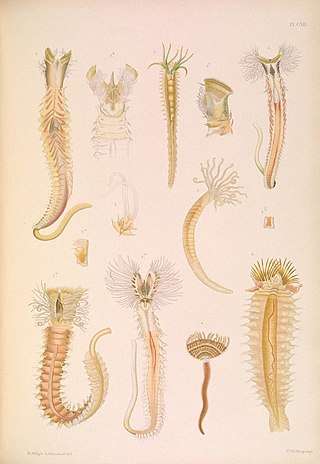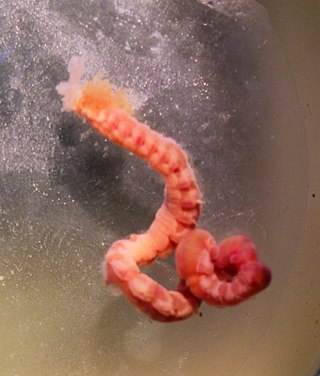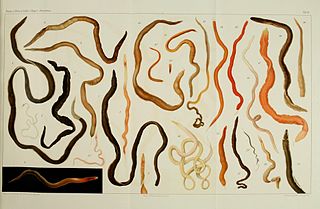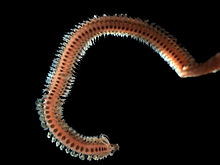
Polychaeta is a paraphyletic class of generally marine annelid worms, commonly called bristle worms or polychaetes. Each body segment has a pair of fleshy protrusions called parapodia that bear many bristles, called chaetae, which are made of chitin. More than 10,000 species are described in this class. Common representatives include the lugworm and the sandworm or clam worm Alitta.

Serpula is a genus of sessile, marine annelid tube worms that belongs to the family Serpulidae. Serpulid worms are very similar to tube worms of the closely related sabellid family, except that the former possess a cartilaginous operculum that occludes the entrance to their protective tube after the animal has withdrawn into it. The most distinctive feature of worms of the genus Serpula is their colorful fan-shaped "crown". The crown, used by these animals for respiration and alimentation, is the structure that is most commonly seen by scuba divers and other casual observers.

Phyllodocida is an order of polychaete worms in the subclass Aciculata. These worms are mostly marine, though some are found in brackish water. Most are active benthic creatures, moving over the surface or burrowing in sediments, or living in cracks and crevices in bedrock. A few construct tubes in which they live and some are pelagic, swimming through the water column. There are estimated to be more than 4,600 accepted species in the order.

Lanice conchilega, commonly known as the sand mason worm, is a species of burrowing marine polychaete worm. It builds a characteristic tube which projects from the seabed, consisting of cemented sand grains and shell fragments with a fringe at the top.

Abarenicola pacifica or the Pacific lugworm is a large species of polychaete worm found on the west coast of North America and also in Japan. The worms live out of sight in burrows under the sand and produce casts which are visible on the surface.

Lagis koreni, commonly known as the trumpet worm, is a species of marine polychaete worm found in European waters. It lives within a narrow conical tube made of grains of sand and shell fragments.

Sabellaria spinulosa is a species of marine polychaete worm in the family Sabellariidae, commonly known as the Ross worm. It lives in a tube built of sand, gravel and pieces of shell.

Hediste diversicolor, commonly known as a ragworm, is a polychaete worm in the family Nereididae. It lives in a burrow in the sand or mud of beaches and estuaries in intertidal zones in the north Atlantic. This species is used in research, but its classification is in dispute; in the literature, it is often classified as Nereis diversicolor. Its specific name "diversicolor" refers to the fact that its colour changes from brown to green as the breeding season approaches.

Thelepus cincinnatus is a species of polychaete annelids in the family Terebellidae, which can be found inhabiting a tube of secrete on rocks and shells. The worm is widely distributed, and can be found in almost any region of the oceans at depths ranging from 10 to 4000 meters.
Eunice norvegica is an aquatic polychaete worm found in deep water on the seabed of the northern Atlantic Ocean as well as in the Pacific and Indian Oceans. It is a tubeworm and is often associated with deep water corals.

Diopatra cuprea, commonly known as the plumed worm, decorator worm or sometimes ornate worm, is a species of polychaete worm in the family Onuphidae, first described by the French entomologist Louis Augustin Guillaume Bosc in 1802. It is native to the northwestern Atlantic Ocean, the Caribbean Sea and the Gulf of Mexico.

Phyllodoce maculata is a species of Polychaete worm in the family Phyllodocidae. It is native to the northeastern Atlantic Ocean where it inhabits shallow water areas of sand, mud and stones.

Phyllodocidae is a family of polychaete worms. Worms in this family live on the seabed and may burrow under the sediment.

Scolelepis squamata is a species of polychaete worm in the family Spionidae. It occurs on the lower shore of coasts on either side of the Atlantic Ocean.

Tubulanus superbus, commonly known as the football jersey worm, is a species of ribbon worm in the phylum Nemertea. Found in the northern Atlantic Ocean, the North Sea and the Mediterranean Sea, it occurs from the lower shore down to about 80 m (260 ft), on sand or gravel.

Cerebratulus marginatus is a proboscis worm in the family Lineidae. This ribbon worm has an Arctic distribution, and in the North Atlantic Ocean ranges as far south as Cape Cod and the Mediterranean Sea while in the Pacific Ocean it extends southwards to California.

Leucia nivea is a species of polychaete worm, commonly known as a "scale worm", in the family Polynoidae. This species occurs in the northeastern Atlantic Ocean, the North Sea and the Mediterranean Sea.

Ochetostoma erythrogrammon is a species of spoon worm in the family Thalassematidae. It is found in shallow water in the Atlantic Ocean, the Mediterranean Sea, and the Indian and Pacific Oceans, burrowing in soft sediment.
Sternaspidae, commonly known as mud owls, are a family of marine polychaete worms with short swollen bodies. They have a global distribution and live buried in soft sediment at depths varying from the intertidal zone to 4,400 m (14,400 ft).

Phyllodoce lineata is a species of polychaete worm in the family Phyllodocidae. It is native to the northeastern Atlantic Ocean and the Mediterranean Sea where it occurs in the intertidal and shallow sub-tidal zones on soft sediment.

















